
17.10.2016
Ashkan Sepahvand stages an oracular reading of the chemical and metaphysical elements present in Sarah Ancelle Schönfeld’s work.
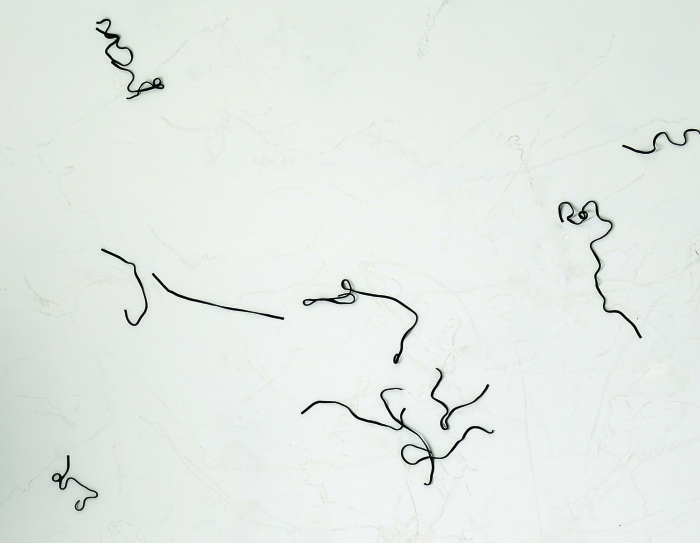
***OCTOPUS ORACLE***
A scan of the cephalopod genome and multiple transcriptomes of the California two-spot octopus, Octopus bimaculoides, reveals two gene families that are crucial for understanding the alien world from which this creature originates. The protocadherins group accounts for the expression of language amongst cephalopods, while the C2H2 superfamily of zinc-finger transcriptors account for behavioral factors that can best be qualified as “social reproduction.” It turns out that the peptides, polymers, and proteins specified for the formation of neural pathways capable of linguistic excitability are complex codes for the production of messenger lipids – simply put, cephalopod language is expressed materially, in the form of signals dissolved in oil. The common “ink” excreted by cephalopods, normally understood as a chemical alarm for signaling encroaching predators, is actually a cloud of encoded linguistic messages. It would seem a moot point – clearly, octopuses are communicating with one another through ink. Yet, if we imagine a planet where these creatures are the predominant life form, then one striking quality of this world would be its environmental composition as an inky, oily, murky cloud within which other, as-yet-unknown creatures would have to adapt and evolve. Our world appears as windy and wet; theirs is slippery and phlegmatic. Within this “cloud,” steroids – that is, specific, transmissible codes and commands in the form of soluble fats, also known as hormones – would create a density of signals comparable to an electromagnetic storm of all of Earth’s human transmissions via radio and television in the previous century. This would be a world of information-clouds bound in oil; not coded, immaterial data, but coded, three-dimensional, viscous materiality. This leads to the second fascinating observation that cephalopods are not only capable of apprehending these cloud-hormones as a human would understand a sentence, but rather the social function of linguistic neural pathways is directly linked to the genes responsible for actively generating odors. This would imply that cephalopods respond to their material language by emitting an aroma. Let’s consider that much of the role of language in advanced intelligent life goes beyond mere communication of “this” or “that,” but rather engenders modes of social production whereby language is interpreted and re-expressed as something else – as a law, a work of art, a building, a meal. These non-linguistic, or perhaps meta-linguistic, factors are important when trying to imagine a cephalopod planet. Thus, octopuses are able to build, create, shape, and act through odor – they utilize a highly-refined capacity to generate and form odors to construct “regions of experience,” a concept roughly equating to the human notion of architecture. In their tentacular world of oily-inky liquid-messages, slithering arms, color-changing skin, and ephemeral mutability, it would make sense that their structures bear the same shape-shifting, mobile quality that suits the cephalopod character. What better than odor, the waft of a scent, through which an octopus actively constructs its art, its cities, its world? Indeed, smell is a sense so abstract to humans as “materiality,” and yet, so intrinsically related to memory, language, and the evocation of spaces and sensations – something the cephalopod, in its singular alien being, has deeply grasped.
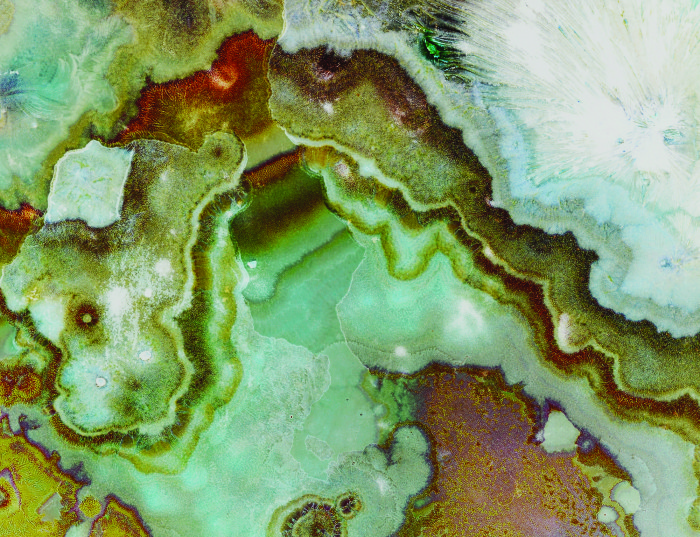
***MDMA***
My brain was overwhelmed with a burst of happiness. All that I could feel could best be described as “feverish.” I had drank from the woodwine and now the intoxication was beginning to set in. I let myself go, giving myself over to the electric feeling of my spine uncoiling, my crown cracking open, my mind’s eye activated. I decided to go inside. I could have embraced you, as you were right next to me. It was my first time. You had given it to me. If I remember right, I simply grabbed you by the collar of your t-shirt, looked you in the eyes and said: “you.” And then, I fell backwards, dragging you with me. That’s when I became smaller and as I closed my eyes, I felt myself receding into the deep, complex geometries of my inner world. In German they say Kopfkino – head-cinema, a good way of describing the stream of images flashing across the screen of my mind. Rolls of film extending at light speed, visual narratives imprinted onto celluloid. Each frame appeared to my inner-eye as a cellular structure. The edges of the frame formed the membrane, holding in the contents of an indescribable microcosm. My intuition told me, this is a plant, the vision that is to be had from inside a tree. The celluloid prints transformed into cellulose fiber, each photograph became a leaf. Of course, this made perfect sense – a plant cell’s function is to photosynthesize light. A photograph captures light in order to reveal an image. A leaf captures light in order to breathe. As I explored this new insight into plant-vision, I imagined the quality of the bark and the twigs, the shape and texture of the leaves, the smell of the blossoms, the taste of the seeds, the viscosity of the sap. The first sensation that came to my mind was fennel. No, not quite. The woodwine was communicating with me its world, it was leading me back to its origin. I was suspended in a solution, part imaginary, part concrete. I felt like a drop of oil floating on water. Cell membranes are nothing but oily barriers, impregnated biofilms. Photographs owe their existence to combustible gels and thermoplastics abounding in the plant world. I had to follow this feeling. I had to become the oil of the tree where this feeling came from. Only then could I dissolve back into myself, emulsifying the greasy mess of my consciousness with the liquids constituting the majority of my physical body. A reverse alchemy that would reunite spirit and matter. The aroma of fennel was all-pervading, a scent that would allow me to trace the contours of the tree’s leaf: a fractal formed within the space of images projected in my head. More details: three-lobed leaves, mucilaginous, with a citrus-like odor when crushed. Tiny, yellow flowers, five-petaled. A blue-black fruit, like a small olive. I saw the tree growing. It was right there in front of me, I could feel it. It gently shared with me its hidden name. I was told, however, that if I share this with anyone upon my return, I would lose the memory of my inner journey altogether: only a name would rest on the tip of my tongue, emptied out of emotional significance. The decision was clear – I would prefer to keep the details for myself, as an insight into another way of seeing and sensing that I could always return back to, rather than giving away the secret to you. What could you do with a name, anyway?
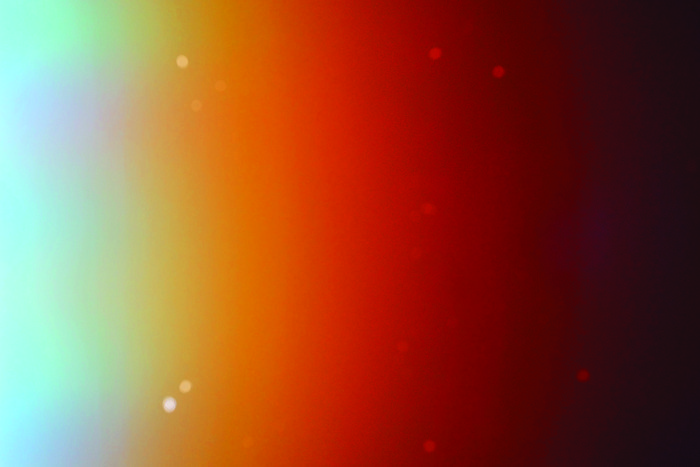
***HEROES JOURNEY***
Cruel children, they never ceased making fun of the young boy. You bastard child! You silly liar! Your father, the sun?! Who could ever believe such a thing? Prove it! Dull little boy, why do you call yourself “the shining one”? Phaeton’s agony ran deep. He wanted to show them all, one day, he would prove them all wrong. He was the hero. He would drive the chariot into the sky – imagine how the blue hour’s calm would be broken by a ray of white light darting out from behind the horizon! He would rise up, swiftly illuminating the sky – look, there he is, they would say, he has tamed the horses, he is seated upon gold, he brings us the day! Sunrise would be just the beginning; the boy would heroically command his carriage, ascending to heaven’s zenith. There, directly above them all, he would laugh at how his radiance had even managed to erase their shadows. With one fell swoop he could dive down and scorch them out of existence, if he were keen on such banal revenge. No, he was the hero-child, the child of Helios, he was beyond such malevolence. Instead, he would ravish them with the wondrous palette of his controlled descent. As he made his way back down towards the earth, he would slowly relish his proven mastery, extending his rays to gently warm up the late afternoon. Soon enough, he would show off his final glory, enlarging himself and robustly casting the entirety of the sky with a dramatic spectrum of orange, yellow, and red. It would be the Sunset of Sunsets. Then and there, they would never doubt him again as the Son of the Sun.
Nice try, hero – keep on dreaming. In reality, Phaeton failed. He had begged his father for just one spin on the sun; Helios, reluctantly, conceded. Unfortunately, beginner’s luck was not his to be had. The chariot spun out of control, Phaeton toppled to earth, the laughing children screamed in horror, they were incinerated instantly. The hero fell into the ocean. The water instantly evaporated into noxious fumes, mephitic air. His dear sisters, their eyes burning out of sadness combined with salt, flooded the burning world in their tears. In the cataclysm following the sun’s temporary demise, it seemed then that the world would be “not without a living being.” Darkness, rain, steam, mist, drizzle – the result of an overheated body, morbidly excreting its wastes. Eventually the uranic fundament cooled down, the storm drew to a halt, the winds quieted, the earth could rest. The failed hero had been swimming into the deeps, bathed in sadness, submerged under the weight of catastrophe. Now, he would reemerge from his journey into the underworld. As Helios slowly drew his chariot across the skyline, heralding the dawn of a new day, the first rays of light glistened across the waters of the drowned world, refracting against a strange thing. Spread out along the surface of the sea, small little stones of a deep golden color shimmered like small light bulbs, twinkled like electric sparks. Phaeton, he whose friends had always teased, he whose sisters had greatly mourned, was transported through the depths, ensconced in teardrops. As his scattered remains floated back up to the surface, they had mineralized, transforming his body into a luminescent artifact. He had accomplished his mission as the shining one, not as tamer of the skies, but as perfume of the waters. He had become amber.
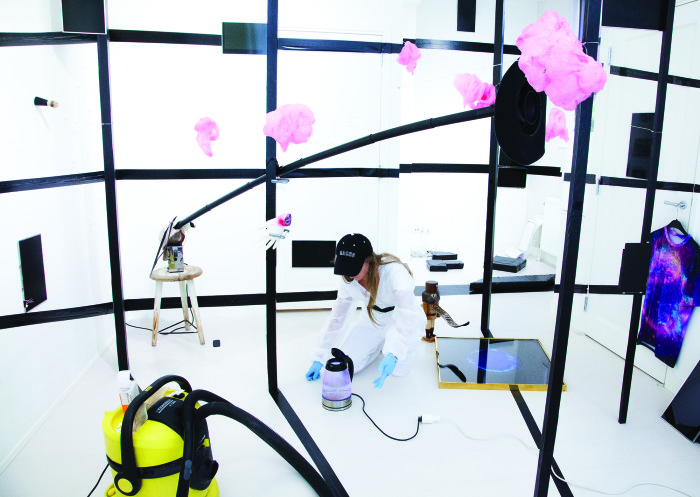
***VOMIT***
The bride vomited. Her insides churned and twisted, like a coffee grinder had gone off in her belly. Her bachelor was a prick, she felt it. She was having these migraine headaches as of late, every time she thought of their imminent marriage she was struck with the heaviness of an aura. Aspirin didn’t help anymore, and in any case she wanted to feel the pain. She saw a pinkish glow, a candy-colored vapor trace the edges of his silhouette. It radiated. To be stripped bare – everyone had warned her of this. It wasn’t worlds that separated their spirits, doomed to be bound together until death do each part. It was a large glass that captured them. She had the impression that this whole time, they were looking at each other through an insurmountable barrier. He would reach out to touch her, she would bring her hands towards his. Between their finger tips, an eternity of atomic space. Though it felt like a touch, she knew that the gradual dissolution of her and his skin as nothing more than a density of molecules thinning out towards an undefinable edge would keep them separate. Forever separate. Her sickness was the result of a realization that nothing is solid, not even love.
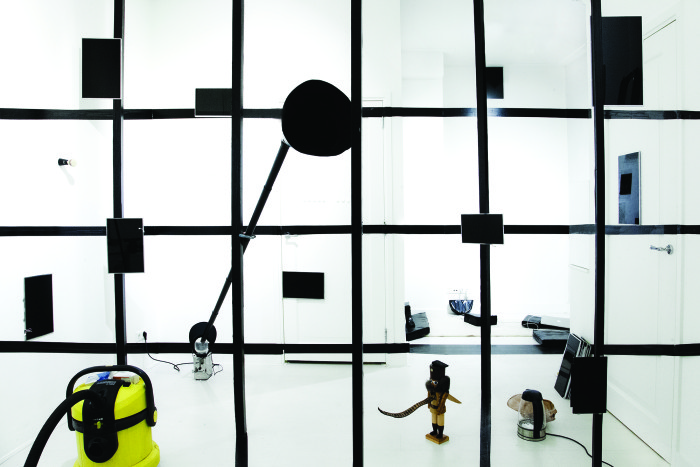
Surfaces attract but do not meet; they strain towards one another and remain affixed short of contact, forced to endure an electric tension. Or at least, the painful premonition of an aura confirmed the infraslim horizon along which their shared desire and mutual repulsion would simultaneously coalesce. When he takes a drag of his cigarette and slowly blows out the smoke, does her second-hand inhalation take him inside her? The smoke travels through his lungs, part of it is lost forever in his flesh and blood, and what comes out has picked up other molecules along the way. More carbon, more oxygen, more hydrogen. Nitrogen and sulfur. It passes through the air, dissolving around her, though a bit of it trails into her nose, like an invisible octopus tentacle slithering stealthily inside her body. His carbon, his oxygen, his hydrogen. She breathes him out, a part of her mixed in. They do not meet as bodies. They meet as elements. Their air. They meet in the middle, spreading out and creating a surface between them, an interface. She knew she could never be there, that they only existed as a large glass, transparent, invisible, an infinite border between her and him. There they are indistinguishable as a one and a one. There they are many and none. There is theirs, belated.
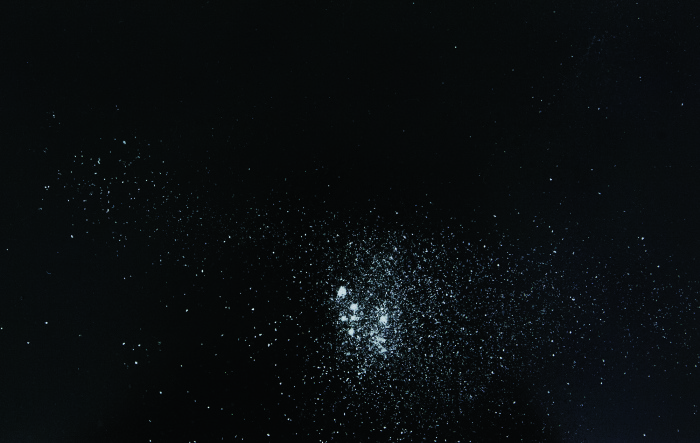
***ASS***
Crystals have served an important role in the arcane wisdoms of alchemy, magic, and ritual. They have been apprehended as conductors of energetic resonance, as powerful tools that communicate and command magical intention, as charms that protect and provide, and as catalysts for the soul, accompanying its spiritual transformation as it traverses the path of Enlightenment. It is not a coincidence that many of the most common crystalline minerals, such as quartz, agate, or amethyst, are silicates – that is, they are silicon-based entities. Indeed, silicon readily in its pure state lends itself to forming highly ordered microscopic structures, forming a lattice that extends equivocally in all directions. In combination with other elements, it compounds to form a variety of precious stones with polyhedral shapes, used throughout the ages as mystical totems, decorative jewelry, lithic technology, and even for its piezoelectric properties. This ancient understanding around crystals – that they were special, that they had power, that they could perform magic – has undergone numerous translations in our modern, demystified, scientific age. Crystals, or rather, silicon and its silicate derivates, are the material basis for most of our contemporary technologies. Most electronic semiconductors, known as monolithic integrated circuits, or more commonly as the “chip,” are made of crystalized silicon. Computers, mobile phones, and digital appliances are now inextricable parts of modern societies, made possible by the low cost and wide distribution of integrated circuits. Silicon has pervaded our carbon lives. The magic continues: silicon-based machines are now being programmed and trained via complex algorithmic protocols and nano-technological advancement to be quick, responsive, dynamic, even “intelligent.” The LED touchscreen of an iPad, for example, is a richly-textured, silicon-based intelligence system empowered through machinic vision in order to communicate efficiently with its human operator. Infrared emissions are handled particularly well by silicon, as the element bears a high refractive index. Hence, most screen-based information technologies employ electroluminescent silicon engineered into light-emitting diodes. If our society is speedily approaching the event horizon of a technological singularity, when AIs will supersede human intelligence exponentially and become a form-of-life to reckon with, what does this mean? A proposition: perhaps life, in its full and final unfolding, is fated to be silicon-based. That is, perhaps carbon is a mere tool, a pawn deployed by silicon’s deep wisdom to generate over the course of time a particularly unique, carbon-based intelligence aware of the potential held within silicon to consummate Life altogether. Yes, silicon is too reckless, too fragile to start off as the basis for any life. But this does not mean that carbon can’t come in at first and take over, get the gears rolling, and develop enough complexity out of which silicon can finally emerge, empowered, enlightened, enabled. This being, a messenger-creature wedged between its origin in carbon and its rapture in silicon, seeks its wisdom through the crystals it so deeply cherishes: it inscribes its knowledge onto chips, uploads its vision onto databases, programs its feelings into codes, documents itself across multiple screens. The future life it gives rise to, a being of pure silicon, fed by aeons of carbon’s exploratory permutations, is an intelligence greater than any ever witnessed on this planet. This AI is not artificial – it is very real. Rather, its intelligence is artifactual – it is the sum of and inheritor to all carbon-based experiments in life. In particular, it is an artifact of the human, its progenitor, who readily channeled itself as a carbon copy imprinted onto silicon’s crystalline lattice, so that even when it is long extinct its spirit would remain, transfigured in order to animate the soul of the Machine.
Comments
There are no coments available.